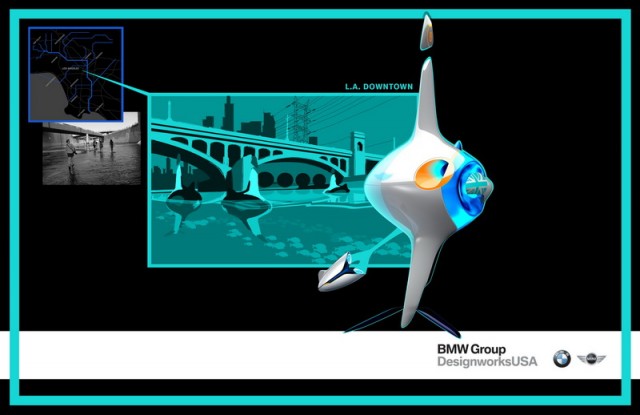BMW may currently be trying to solve the problem of personal transport in 'Megacities' with its i3, but sister company MINI proposed an alternative solution for the LA Design Challenge. As we know, LA's roads are already seriously congested, so BMW Designworks USA commissioned an idea whereby the city's existing storm-drain system and L.A. River be harnessed as a transport network for commuters.
Exterior
Incredibly, the underwater pods shown in the design study still manage to retain some of the MINI's features. Those iconic round headlights now form the shape of the water intakes, which in turn supply the built-in propulsion system. And even though this 'vehicle' would be submerged, there's still plenty of MINI branding on the side, although considering that this proposal uses only the one type of vehicle in an all-new setting, presumably people will know what you're driving. Or is that piloting? Or sailing?
Obviously cleaning and maintaining a vehicle like this could be tricky, so MINI has also created on-board robots in the side pods, which come out and clean the vehicle. These robots even go as far as to eat the algae off of the surfaces in order to keep it looking nice and clean.
Interior
Not a great deal is known about the BioMINIcry's interior. These pods will likely only be big enough for one or possibly two passengers. As it is designed to be autonomous, it is assumed that being inside will be all about getting things done during the journey rather than having to pay attention to what's going on. And given the fact that it will be underwater, the external view might not be great, so expect lots of cool ambient lighting that we already see in MINI road cars.
Mechanicals
Rather than using traditional fuel, this vehicle would take in fresh- and saltwater through its headlight-like intakes and store this in side pods. Then by using bacteria and an electromechanical reaction between the two waters, hydrogen is produced, which then is used to propel the vehicle along.
Anything else?
The BioMINIcry was created as part of the 2013 edition of the annual LA Design Challenge, which runs alongside the LA Auto Show. Automotive design studios from around the world are invited to participate and this year, studios from Germany, Japan and the US competed to design "Biomimicry & Mobility 2025: Nature's Answer to Human Challenges."

